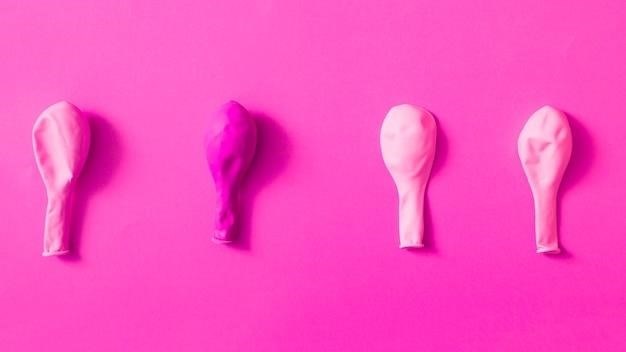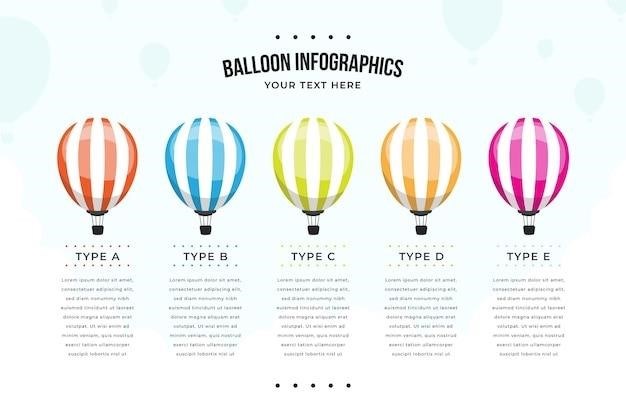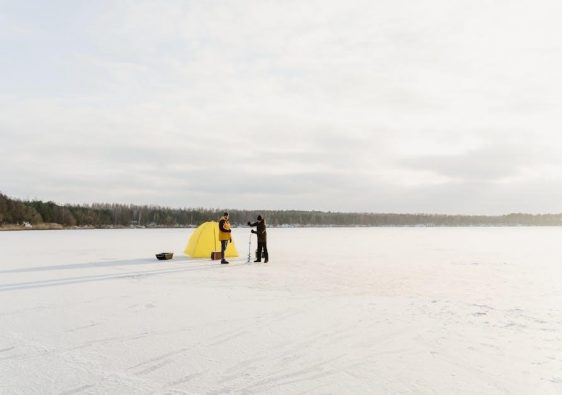Balloon Size Guide⁚ A Comprehensive Overview
This guide provides a complete overview of balloon sizes, covering standard measurements in inches and centimeters, common latex and foil balloon sizes, and resources for finding specific size information. Understanding balloon sizing is crucial for successful party planning and decoration projects, ensuring the right fit for various applications.
Standard Balloon Sizes
Standard balloon sizes are typically defined by their diameter when fully inflated. While variations exist across brands, common sizes for latex balloons include 5-inch, 9-inch, 11-inch, 12-inch, 16-inch, and 30-inch balloons. These measurements are usually given in inches, but equivalent centimeter measurements are readily available. The 11-inch (approximately 28cm) balloon is frequently cited as a standard size, offering a good balance between visual impact and ease of handling. However, the “standard” can depend on the specific application; for instance, smaller balloons might be preferred for delicate designs, while larger balloons are ideal for creating impactful statements or balloon arches.
It’s crucial to check individual manufacturer specifications as slight variations can occur. Consider the intended use when selecting a balloon size; a wedding arch might necessitate larger balloons than those used for a child’s birthday party. Size charts provided by balloon retailers can be invaluable tools for planning and selecting the appropriate balloon size for your project.
Latex Balloon Sizes in Inches and Centimeters
Latex balloons are available in a wide range of sizes, typically expressed in both inches and centimeters. Common sizes include 5 inches (12 cm), 9 inches (22 cm), 11 inches (28 cm), 12 inches (30 cm), 16 inches (40 cm), and even larger sizes such as 30 inches (75 cm) or more. These measurements refer to the diameter of the balloon when fully inflated. It’s important to note that slight variations may exist between different manufacturers’ products, so always refer to the specific supplier’s size chart for precise dimensions. Conversion between inches and centimeters is straightforward; one inch is approximately equal to 2.54 centimeters. When ordering balloons online or from catalogs, ensure you’re aware of whether the size is stated in inches or centimeters to avoid miscalculations.
Understanding the size differences is vital for planning balloon decorations. Smaller balloons are suitable for intricate designs or clusters, while larger balloons create a bolder visual impact. Always check the product description for accurate measurements to ensure your chosen balloons are the right size for your specific project or decorative scheme. Accurate measurements are key to achieving the desired aesthetic.
Commonly Available Latex Balloon Sizes
While a vast array of latex balloon sizes exist, certain dimensions are far more prevalent than others. The most commonly found sizes in party supply stores and online retailers typically range from 5 inches (12cm) to 12 inches (30cm) in diameter. The 11-inch (28cm) balloon is a particularly popular choice, often considered a “standard” size for its versatility in various decorative applications, from simple bouquets to more elaborate arches and garlands. Nine-inch (22cm) balloons offer a slightly smaller, yet still impactful alternative, ideal for creating denser clusters or intricate balloon arrangements. Larger sizes, such as 16 inches (40cm) and even 30 inches (75cm) or more, are frequently available for making striking centerpieces or large-scale installations, but often come at a higher cost.
The availability of these common sizes reflects their widespread use across diverse celebratory events. Party planners often rely on these readily accessible dimensions to create a variety of visual effects and to meet the needs of various project scales. For unique or less standard sizes, it’s recommended to consult specialty balloon suppliers or online retailers who may offer a more comprehensive range of options.

Microfoil Balloon Sizes
Unlike latex balloons, microfoil balloons, also known as Mylar balloons, come in a wider variety of shapes and sizes, often exceeding the dimensions typically found in latex options. While the standard round shape is available in sizes comparable to latex balloons (e.g., 18 inches), many microfoil balloons are designed in unique shapes like stars, hearts, numbers, or even characters. These shapes often have less standardized size measurements, with dimensions varying significantly depending on the design. For example, a large foil number balloon might have much larger height or width dimensions than its diameter equivalent in latex.
Size variations also depend heavily on the manufacturer and specific design. Always check the product description or packaging for precise dimensions before purchasing, as a “18-inch” foil star may not have the same overall size as an “18-inch” round foil balloon. This lack of standardization necessitates careful attention to detail when planning a design incorporating microfoil balloons, particularly when working with multiple shapes and sizes. Always prioritize confirming the exact dimensions, rather than simply relying on general size classifications.
Balloon Size Charts⁚ Finding the Right Fit
Balloon size charts are invaluable tools for event planners and decorators. These charts visually represent the size differences between various balloon types, often including both latex and foil options. They typically list dimensions in both inches and centimeters, providing a clear comparison. Many charts categorize balloons by size classifications (small, medium, large, etc.), simplifying the selection process. However, remember that size can vary slightly between brands.
When using a size chart, pay close attention to the specific balloon type listed (latex, foil, etc.), as dimensions differ significantly between materials. Furthermore, note any special shapes or designs, as these can impact overall dimensions. For example, a heart-shaped foil balloon may have different height and width measurements compared to a similarly-sized round balloon. Utilize these charts to visualize the scale of your balloon decorations, assisting in accurate quantity estimations for arches, garlands, or other arrangements. Referencing multiple charts from different suppliers can offer a more comprehensive understanding of size variations across brands.

Understanding Balloon Size Variations Across Brands
While standard balloon sizes exist (e.g., 11-inch latex balloons), variations occur across different brands. Manufacturing processes and the specific materials used can subtly affect the final inflated size. A seemingly standard 11-inch balloon from one manufacturer might measure slightly larger or smaller than a similar balloon from another. This is due to factors such as the thickness of the latex or the precision of the manufacturing machinery. These discrepancies are usually minor, but they can become significant when dealing with large quantities of balloons or intricate balloon arrangements;
Before purchasing balloons for a large-scale project, it’s advisable to test-inflate a few balloons from the chosen brand to ascertain their actual inflated size. This will allow you to accurately gauge how many balloons you need to achieve your desired effect. Comparing size charts from multiple vendors can also help you understand the range of size variations and choose a brand that consistently aligns with your needs. Pay close attention to the manufacturer’s specifications, as they often provide detailed size information and may even offer a tolerance range for inflated dimensions. This proactive approach ensures that your balloon decorations meet your expectations.
Using Size Charts for Specific Balloon Applications
Balloon size charts are invaluable tools for various applications beyond simple decoration. For creating balloon arches or garlands, size charts help determine the number of balloons needed for a specific length or design. Different-sized balloons can be strategically combined to create visual depth and interest. For example, a mix of 11-inch and 16-inch balloons can add visual dynamism to an arch. When making balloon bouquets, size charts help maintain a balanced and aesthetically pleasing arrangement. Smaller balloons can serve as fillers to complement larger feature balloons. The size chart aids in choosing the right balloon for a specific event. Large balloons (e.g., 36 inches) are ideal for creating statement pieces at larger events, while smaller ones might be better suited for intimate gatherings.
Size charts are also essential when creating balloon sculptures or custom designs. Precise balloon sizing ensures the final sculpture’s accuracy and visual appeal. Additionally, if using balloons for themed parties, the size chart helps select the right-sized balloons to accurately represent characters or objects. When considering weight, size charts can be crucial. Larger balloons require more helium, and understanding this relationship ensures you have enough to sufficiently inflate all your balloons. Therefore, careful consultation of size charts is key to successful balloon-based projects, maximizing their visual impact and ensuring efficient use of resources.
Balloon Size and Quantity for Specific Decorations (e.g., arches, garlands)
Planning balloon arches or garlands requires careful consideration of balloon size and quantity. For a classic arch, a mix of 11-inch and 16-inch latex balloons is often used, with the larger balloons providing a base structure and the smaller ones filling in gaps for a fuller look. The number of balloons needed depends on the desired arch length and fullness. A general rule is to estimate around 20-30 balloons per foot for a standard arch, but this can vary based on the desired density and balloon arrangement. Garlands often employ a wider range of balloon sizes, including smaller 5-inch balloons for detail and larger balloons as focal points, creating visual interest and texture. The quantity needed for garlands depends on the design’s complexity and length. Simple designs may require fewer balloons, while intricate designs might need 50 or more balloons per foot. Using a variety of sizes creates a more visually appealing and less uniform look. Consider incorporating different colors, finishes (matte, metallic), and even adding balloon accessories like ribbons and streamers to enhance the overall effect. Remember to account for balloon wastage – always buy a few extra balloons to compensate for any pops or defects.
Large Balloon Sizes and Their Uses
Large balloons, typically 30 inches or larger in diameter, offer a dramatic visual impact and are perfect for creating stunning centerpieces or eye-catching focal points at events. These oversized balloons are often used for grand entrances, photo backdrops, or as standalone statement pieces. Their impressive size makes them ideal for creating a sense of scale and wonder. Giant balloons can be filled with helium for floating displays, or air-filled for ground-based installations. The larger size allows for greater creative flexibility. For example, you could create unique shapes and characters by combining multiple large balloons or using them as the base for balloon sculptures. Common uses for large balloons include weddings, corporate events, product launches, and large-scale celebrations. They can be customized with branding, logos, or personalized messages for promotional purposes or to celebrate special occasions. While larger balloons require more careful handling and potentially specialized inflation equipment, the visual impact they create is undeniable, transforming any space into a memorable and exciting event setting. Choosing the right large balloon size depends on the intended use and the overall scale of the event. Careful planning is essential to ensure they are appropriately sized for the venue and the desired aesthetic effect.
Converting Balloon Measurements⁚ Inches to Centimeters and Vice Versa
Accurate conversion between inches and centimeters is vital when working with balloon sizes, ensuring you select the correct balloon for your needs. One inch equals approximately 2.54 centimeters. Therefore, to convert inches to centimeters, multiply the measurement in inches by 2.54. For example, an 11-inch balloon is roughly 28 centimeters (11 inches x 2.54 cm/inch ≈ 27.94 cm). Conversely, to convert centimeters to inches, divide the measurement in centimeters by 2.54. A 30-centimeter balloon is approximately 11.8 inches (30 cm / 2.54 cm/inch ≈ 11.81 inches). Online converters are readily available for quick and accurate conversions, eliminating manual calculations. These tools are invaluable when comparing balloons from different suppliers or when working with international balloon size charts. Remember that slight variations may occur between brands and manufacturers; therefore, these conversions provide approximations rather than exact values. Using these conversion methods ensures you can confidently compare balloon sizes regardless of the unit of measurement used, leading to a more precise selection process for your balloon projects. Precise measurements are crucial for guaranteeing the successful execution of your balloon arrangements, whether it’s a simple balloon bouquet or a complex balloon arch.
Resources for Finding Balloon Size Information
Numerous resources are available for obtaining comprehensive balloon size information. Online retailers specializing in party supplies often provide detailed size charts on their websites, specifying dimensions in both inches and centimeters for various balloon types (latex, foil, etc.). These charts frequently include images showcasing the relative sizes of different balloons, aiding visual comparison. Manufacturer websites also offer valuable information, sometimes providing downloadable PDF size guides or detailed specifications. Additionally, searching online using terms like “balloon size chart,” “latex balloon dimensions,” or “foil balloon sizes” yields numerous results, including articles, blogs, and forums dedicated to party planning and balloon artistry. These resources may provide comparisons across brands and offer insights into balloon size variations. Finally, contacting party supply stores directly can provide personalized assistance in selecting the appropriate balloon sizes for specific projects. Remember to always verify the information from multiple sources to ensure accuracy and consistency, especially when working on large-scale balloon decorations or projects requiring precise measurements. Thorough research will ensure the successful execution of your balloon projects.


